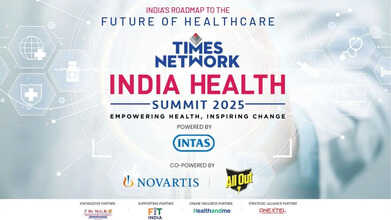- Health Conditions A-Z
- Health & Wellness
- Nutrition
- Fitness
- Health News
- Ayurveda
- Videos
- Medicine A-Z
- Parenting
- Web Stories
How These Celebrities Have Managed Their Diabetes?

Credits: Canva
Managing diabetes requires consistent effort, lifestyle changes, and a proactive mindset. While the diagnosis may feel overwhelming at first, several celebrities have opened up about how they live with the disease—and thrive. From adjusting their diets and exercise routines to emphasizing mental health, their stories serve as powerful reminders that diabetes can be controlled. Here’s how some well-known personalities manage their condition—and what you can learn from them.
Maheep Kapoor: Empowered by Awareness
Maheep Kapoor recently revealed her Type-1 diabetes diagnosis on the Netflix show Fabulous Lives vs Bollywood Wives. Calling the diagnosis “liberating and empowering,” she told HT City: “I am not going to let the disease control me or my narrative. I’m going to control the disease.”
For Maheep, managing diabetes begins with weight training and a structured exercise routine. She also highlights the importance of balanced meals and eating at the right time. “Now I've had to modify my way of eating. It’s eating your proteins first and having fruits as dessert,” she shared. She also avoids long gaps between meals to keep her blood sugar stable. Her approach reflects a fundamental truth: mindful eating and consistency matter.
Sonam Kapoor: Choosing Health Over Rituals
Sonam Kapoor was diagnosed with Type-1 diabetes at the age of 17. Despite being part of a culture that values religious fasting, she opts out of practices like fasting during Karwa Chauth due to health risks. “I don’t fast FYI, but I like the mehendi, dressing up, and food,” she said on Instagram.
Sonam’s story underlines the importance of listening to your body and not adhering to social norms at the cost of your health. She focuses instead on balanced meals and staying active—key elements in blood sugar management.
Fawad Khan: Routine and Professional Guidance
Pakistani actor Fawad Khan also received his Type-1 diabetes diagnosis at 17. He swears by a diet low in high glycemic index carbs, paired with lean proteins and vegetables. He also relies on medical support, including metformin, to manage insulin sensitivity and follows a personalized plan with a nutritionist.
His emphasis on routine monitoring and seeking expert advice shows that managing diabetes isn't about guesswork—it’s about informed action.
Gaurav Kapur: Stress Management as a Tool
For actor and cricket presenter Gaurav Kapur, managing diabetes for over 12 years means planning even amid an unpredictable schedule. “I ensure seven hours of sleep, eat on time, and take small meals at regular intervals,” he said. Importantly, he stresses managing stress, calling it a major factor in worsening symptoms.
Regular exercise and conscious de-stressing help him stay both physically and mentally balanced.
Nick Jonas: Planning Around the Unpredictable
Diagnosed with Type-1 diabetes at 13, singer Nick Jonas has spoken openly about the challenges of managing his condition while on tour. “There are days that are unpredictable and challenging and you need to just find your way through it,” he said.
He sticks to routine meal planning, frequent self-monitoring, and mindfulness. Jonas shows that with the right tools—like blood glucose monitors and meal prep—even the busiest lifestyle can accommodate effective diabetes care.
Tom Hanks: A Wake-Up Call for Lifestyle Change
Academy Award-winning actor Tom Hanks was diagnosed with Type-2 diabetes in 2013. He attributes it to poor lifestyle choices earlier in life and now sticks to a structured fitness routine. “I watch what I eat to a point of boredom,” he admitted, adding that he tries to stay active for at least one hour every day.
His story is a reminder that lifestyle corrections, no matter when you start, can help manage diabetes and improve overall health.
Is Your Body Aging Too Quickly? 5 Warning Signs You Shouldn’t Ignore

Credits: Canva
Aging is a natural process. It happens when the rate at which our cells die begins to outpace the rate at which they regenerate. Every cell in the body has its own lifespan, for example, red blood cells live for around 100 to 120 days, while liver cells (hepatocytes) last about 200 to 300 days. Over time, as regeneration slows, the signs of aging begin to appear.
However, in some people, this process speeds up. Factors like long-term exposure to toxins, severe physical trauma, metabolic disorders such as cancer, or the failure of vital organs can push the body into premature aging. We got in touch with Dr Saurish Hegde, MD community medicine, Public health specialist who told us more about the same.
Warning Signs You May Be Aging Faster
- Constant fatigue and loss of energy: Everyday tasks feel harder, and the body tires more quickly than before.
- Skin and hair changes: Reduced collagen and keratin production leads to sagging, wrinkles, and thinning or loss of hair.
- Cognitive decline: Memory lapses, difficulty in planning, and problems with calculations may point to aging-related changes in the brain as grey matter begins to shrink.
- Chronic conditions: Lifestyle diseases like diabetes and hypertension are often tied to aging, linked to reduced insulin production and thicker, slower blood flow.
Can Premature Aging Be Prevented?
While no one can stop the clock, adopting healthy habits can slow it down. Regular physical activity, a diet rich in antioxidants from fruits and vegetables, quality sleep, and timely health screenings can all help delay the impact of aging and keep the body functioning better for longer.
What Causes Premature Aging?
In most cases, premature aging happens because of everyday habits or environmental factors that we can control. Doctors call this extrinsic aging. The first signs usually show up on the skin. While skin changes are a normal part of getting older, if they appear too early, lifestyle and surroundings are often to blame.
Light exposure is the biggest culprit
- Sunlight (UV rays): Too much sun speeds up skin aging, a process known as photoaging. This alone causes about 90% of the visible changes we see in skin, such as wrinkles, age spots, and rough texture. UV rays also damage cells, which raises the risk of skin cancer.
- Blue light and infrared light: The remaining 10% of skin damage comes from high-energy visible (blue) light and infrared light. Blue light comes from the sun and also from screens, while infrared is the heat we feel. These don’t raise cancer risk but they do weaken collagen and elasticity, making skin sag sooner.
- Smoking: Nicotine toxins break down collagen and elastin, causing sagging skin, wrinkles, and a hollow look.
- Poor diet: Diets high in sugar and refined carbs may speed up aging, while diets rich in fruits and vegetables help protect the skin.
- Alcohol: Heavy drinking dehydrates and damages skin over time.
- Lack of sleep: Poor or insufficient sleep has been linked to faster cellular aging.
- Chronic stress: High cortisol levels from stress reduce substances like collagen and hyaluronic acid that keep skin smooth and firm.
In rare cases, certain medical conditions can also cause early aging, such as progeria, Werner syndrome, Cockayne syndrome, Bloom syndrome, and a few other genetic disorders.
The Most Coveted Gathering of India’s Healthcare Leaders: TIMES NETWORK INDIA HEALTH SUMMIT 2025

India’s healthcare leaders are set to gather at the eagerly awaited TIMES NETWORK INDIA HEALTH SUMMIT 2025. With the country positioning itself as a global healthcare hub, the Modi government is pushing reforms aimed at creating a strong healthcare system. The sector has seen remarkable changes, driven by advancements in technology, improved infrastructure, and wider accessibility. Recognizing healthcare as a strategic pillar, the government views it as essential for national growth, public welfare, and economic stability.
In 2025, healthcare will remain an essential part of India’s economy, contributing significantly to GDP growth, job opportunities, and technological progress. The industry, valued at over $500 billion, sustains millions of jobs across hospitals, pharmaceuticals, biotechnology, and health-tech. Rising demand for quality care, especially in Tier 2 and Tier 3 cities, is pushing more investments and large-scale infrastructure development.
Efforts to strengthen public health are closely aligned with the Sustainable Development Goals (SDGs), emphasizing sustainable healthcare through optimal technology use. This year, the summit will focus on key themes such as “Making Healthcare Sustainable with Optimal Use of Technology” and “Adoption of Technology for Improved Accessibility and Affordability.”
The summit will host over 30 expert speakers, 300 delegates, and eight focused knowledge sessions. Attendees will discuss shaping global healthcare standards, achieving health equity, enhancing accessibility, advancing medical education, research, and driving innovation through technology.
Notable panels include “From Policy to Practice: Making Health Equity a Reality in India”, featuring Dr Sumit Kumar Dubey, Chief Medical Officer, NDMC; Dr Randeep Guleria, Director of Medanta Medical School; and Dr Narinder Mehra, Hon. Emeritus Scientist, ICMR. Another key session, “Battling Dengue in India: Crisis, Control and the Promise of Vaccination,” will include insights from Dr Sanjeev Bagai, Chairman, Nephron Clinic, and Dr Tanu Jain, Director, NCVBDC. TV actress Chhavi Mittal, a breast cancer survivor, will also share her personal journey.
Other highlights feature Dr Ananya Awasthi, Founder & Director of Anuvaad Solutions, and Dr Meenakshi Singh, Chief Scientist, CSIR, discussing nutraceuticals; Dr Shyam Aggarwal, Chairperson Oncology at Sir Ganga Ram Hospital, on cancer care; and Arvind Pachhapur of Strands Life Sciences, exploring AI-driven healthcare solutions. Additional sessions on youth mental health and healthcare infrastructure promise to offer actionable insights for stakeholders.
For more details, visit TIMES NETWORK INDIA HEALTH SUMMIT 2025.
NHS Issues Omeprazole Warning: Safer Alternatives For Heartburn And Indigestion

Credits: Canva
NHS omeprazole warning: People who take the common heartburn and indigestion drug omeprazole have been cautioned by the NHS about its potential long-term risks. For those unversed, omeprazole belongs to a group of medicines called proton pump inhibitors (PPIs). These drugs work by reducing the amount of acid produced in the stomach and are often prescribed for acid reflux, heartburn, and related issues.
They target the stomach’s proton pumps, the enzymes responsible for producing acid. While omeprazole can be very effective, it isn’t the only solution. If you are avoiding the medicine duen to the NHS warning, or just simply struggling with side effects or prefer a more natural route, there are other options worth considering.
NHS Warning on Omeprazole’s Long-Term Use
According to new figures, nearly 73 million NHS prescriptions for PPIs like omeprazole were issued in England in 2022 to 23. Reports also show that around 15% of the UK population relies on PPIs, making them among the most commonly used medications in the country. Alongside heartburn, PPIs are used to manage conditions like indigestion, stomach ulcers, gastro-oesophageal reflux disease (GORD), and even to treat Helicobacter pylori infection when paired with antibiotics. With NHS experts now raising concerns, we spoke to a health professional who explained which safe alternatives people can turn to instead.
Alternatives to Omeprazole
Omeprazole is one of several PPIs available. This class of medication is used for GERD, stomach and duodenal ulcers, and certain bacterial stomach infections. Each drug in the group works by blocking acid pumps in the stomach, but individuals may respond differently. We got in touch with Dr Vishal Khurana, Director Gastroenterology, Metro Hospital, Faridabad who told, us, “If omeprazole causes side effects or drug interactions, switching to another PPI such as pantoprazole (Protonix) or rabeprazole (Aciphex) may be a safer option.”
Other alternatives include H2 blockers like famotidine (Pepcid AC), which reduce acid in a different way, or traditional antacids like Tums and Rolaids that provide quick but temporary relief. There are also newer prescription treatments such as vonoprazan (Voquezna) that could be considered.
Natural Remedies for Acid Reflux and Heartburn
Medication isn’t always the only answer. Many people find relief from acid reflux by making small but consistent dietary and lifestyle changes. Avoiding fatty or spicy foods, cutting back on alcohol, and eating smaller portions can all help reduce symptoms. Simple remedies like ginger tea, milk, or a small amount of apple cider vinegar may also soothe heartburn for some people.
In terms of supplements, deglycyrrhizinated licorice (DGL) has been linked to easing acid reflux, though quality can vary between brands, so it’s best to check with a pharmacist before trying.
Lifestyle habits matter too. Quitting smoking and maintaining a healthy weight have been shown to lower the risk of reflux significantly. While these changes are not always easy, their benefits go far beyond heartburn relief.
The NHS advice doesn’t mean everyone should stop using omeprazole right away, but it’s a reminder that safe alternatives exist, and making simple adjustments could help you avoid long-term risks while still keeping heartburn under control.
© 2024 Bennett, Coleman & Company Limited

